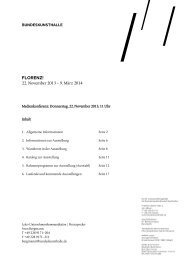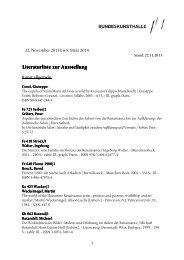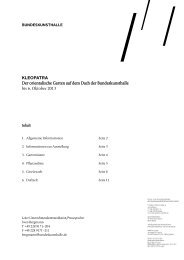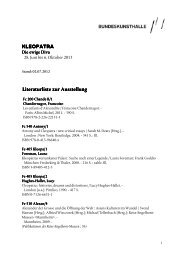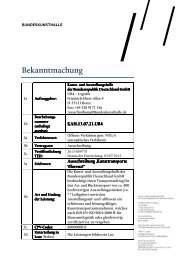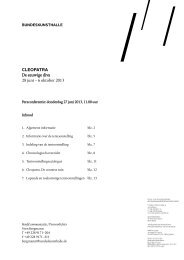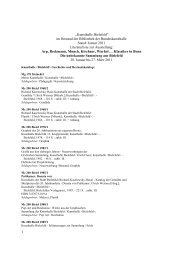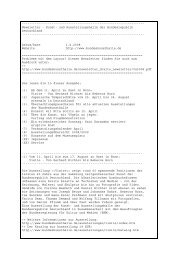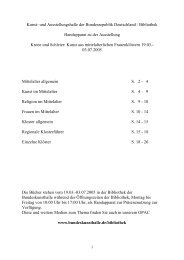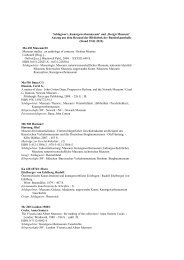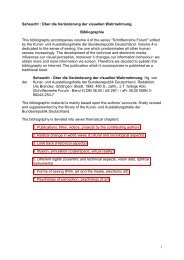Peoples through space and time Archaeology in Germany 09.05 ...
Peoples through space and time Archaeology in Germany 09.05 ...
Peoples through space and time Archaeology in Germany 09.05 ...
You also want an ePaper? Increase the reach of your titles
YUMPU automatically turns print PDFs into web optimized ePapers that Google loves.
Isl<strong>and</strong> of Rügen symbolizes the end of Slavic <strong>in</strong>dependence <strong>and</strong> worship of a heathen religion. In 1168<br />
this ma<strong>in</strong> shr<strong>in</strong>e of the Baltic Sea Slavs was conquered by Christian Danes <strong>and</strong> burned to the ground.<br />
Slavic Fortresses<br />
In Slavic <strong>time</strong>s, ramparts <strong>and</strong> their strong re<strong>in</strong>forcements made of wood <strong>and</strong> earth po<strong>in</strong>ted to regional<br />
centers of political <strong>and</strong> economic power.<br />
Excavations carried out over years at the Berl<strong>in</strong>-Sp<strong>and</strong>au rampart have proven that this site was an<br />
important center of trade situated at the Havel cross<strong>in</strong>g on the trade route from Magdeburg to Kiev.<br />
From the beg<strong>in</strong>n<strong>in</strong>g of the 9 th century the fortified facility developed <strong>in</strong> phases <strong>in</strong>to an early urban<br />
settlement.<br />
The Saxon Graveyard at Issendorf<br />
Issendorf on the Lower Elbe River is long renowned for its ancient Old-Saxon urn burial site with more<br />
than 5000 cremation burials from the 4 th to 6 th century.<br />
In addition, 79 body burials <strong>in</strong> wood-l<strong>in</strong>ed chambers, dated between 400 <strong>and</strong> 550 A.D., were excavated<br />
<strong>in</strong> the 1990s. The bodies were buried <strong>in</strong> tree or wood-planked coff<strong>in</strong>s. The comparably rich burial goods<br />
found there identify them as an elite family who for more than 250 years dom<strong>in</strong>ated the settlement area<br />
around today’s Issendorf.<br />
22<br />
Conservation<br />
Up until a few years ago conservators were not given any special tra<strong>in</strong><strong>in</strong>g. However, the profession does<br />
entail a comprehensive knowledge of cultural history, science <strong>and</strong> other practical specialized<br />
knowledge, which today is taught at universities especially for conservators.<br />
The tasks of conservators <strong>in</strong>cludes carefully conserv<strong>in</strong>g <strong>and</strong> effectively protect<strong>in</strong>g artifacts, while<br />
mak<strong>in</strong>g as little changes to the orig<strong>in</strong>al substance as possible.<br />
Because archaeological artifacts are subject to many corrupt<strong>in</strong>g <strong>in</strong>fluences <strong>through</strong> their long storage <strong>in</strong><br />
the soil, they must be carefully exam<strong>in</strong>ed <strong>and</strong> analyzed <strong>and</strong> an appropriate conservation measure<br />
developed before they are restored <strong>in</strong> any way.<br />
In applied research, materials are checked for their suitability before they are used, <strong>and</strong> new methods are<br />
experimented with, such as laser technology for clean<strong>in</strong>g surfaces or plasma reduction for treat<strong>in</strong>g metal<br />
artifacts.<br />
The Analysis <strong>and</strong> Conservation of Textiles<br />
In contrast to metal, glass or ceramic objects, textiles are highly corruptible <strong>and</strong> therefor are only<br />
preserved <strong>in</strong> soil if conditions are favorable. S<strong>in</strong>ce the 1950s, it has become <strong>in</strong>creas<strong>in</strong>gly possible to<br />
exam<strong>in</strong>e the fabric <strong>and</strong> leather rema<strong>in</strong>s adher<strong>in</strong>g to metal, <strong>and</strong> to determ<strong>in</strong>e the material <strong>and</strong> weave<br />
technique.<br />
Ever s<strong>in</strong>ce textile conservation was <strong>in</strong>tegrated <strong>in</strong> historic preservation offices <strong>in</strong> the 1980s, diverse<br />
<strong>in</strong>sights <strong>in</strong>to prehistoric cloth<strong>in</strong>g have been won from more exact excavations <strong>and</strong> exposures of organic<br />
materials <strong>and</strong> from comprehensive <strong>and</strong> costly analyses.<br />
A Pleated Garment <strong>in</strong> Woman’s Grave No. 138 at Großhöb<strong>in</strong>g<br />
In wooden chamber grave no. 138 an aristocratic woman was laid out with a valuable golden brooch,<br />
bronze arm r<strong>in</strong>gs <strong>and</strong> necklaces made of glass, silver <strong>and</strong> amethyst pearls, her ears were decorated with<br />
gold earr<strong>in</strong>g pendants. Like the woman buried <strong>in</strong> grave no. 160, she wore leather gloves.<br />
Under the dead woman’s pelvis scraps of cloth<strong>in</strong>g were preserved which were salvaged en bloc. Viewed<br />
<strong>through</strong> a microscope, two overly<strong>in</strong>g layers of l<strong>in</strong>en became visible, that of an upper as well as under<br />
garment. A 12 cm long iron brooch was found fastened to the undergarment, which gathered a portion<br />
of the material <strong>in</strong>to a pleat <strong>and</strong> held it fast.<br />
Only <strong>through</strong> the exact analysis of grave no. 138 was it possible to establish proof of the oldest known<br />
pleated garment north of the Alps. Most probably imported from Italy or Byzantium, the pleated cloth<br />
was worn by a woman of the upper class.<br />
23<br />
24




